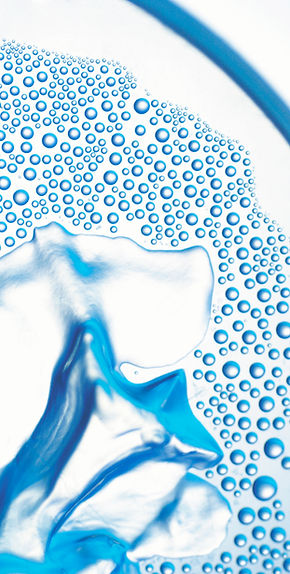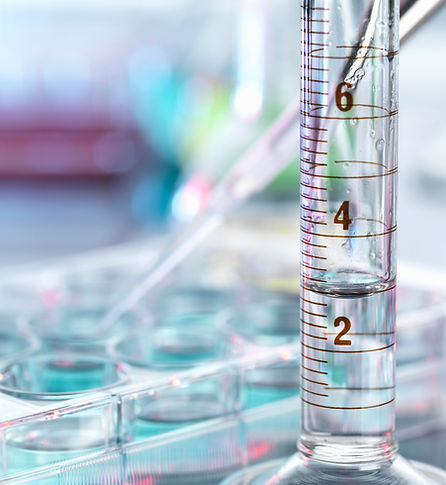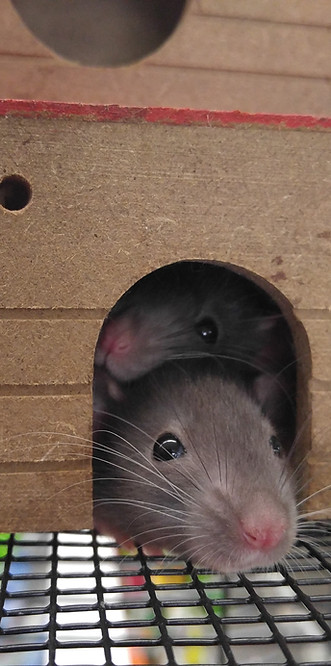
Reproductive Cloning
TECHNIQUES FOR CLONING PLANTS
Cloning is a great option if the price of seeds are high, there is a low germination rate, the crop is easy to clone (such as woody or crops with smaller leaves on obvious stems), or if you want crops with pest and disease resistance.
Some crops that are good for cloning are:
-
Mint
-
Rosemary
-
Basil
-
Thyme
-
Oregano
-
Woody Herbs
-
Tomatoes
-
Peppers


Some crops that are bad for cloning are:
-
Lettuce
-
Kale
-
Chard
-
Mustard Greens
-
Collards
-
Bok Choy
-
Some Large Fruiting Crops
TISSUE CULTURE
WHAT IS IT?
"Tissue culture is a method of plant propagation done in a laboratory.Plant tissue culture involves growing plants in an artificial medium under sterile conditions in a jar, flask or test tube. In theory, this process can go on indefinitely, producing many plants over time. Some plant tissue cultures are started from very small sections of plant tissue. The plants produced this way are exact copies, or clones, of one another. While cloning is important for producing multiples (hundreds, thousands, even millions) of an individual, tissue culture offers other ways to propagate plants that are not "clones." Some plant tissue cultures are started from seeds. When seeds are used for tissue culture, each new plant is genetically different from its parent plant. Many of the orchids grown in the lab are started from seed. Tissue culture is commonly called "cloning" and "micropropagation."


WHY USE IT?
"The plant tissue culture lab allows Garden staff to research new methods of reproducing rare plants and using this information to further plant conservation efforts."
HOW TO DO IT?
"Flasks of nutrient medium are first sterilized under high heat and pressure to kill any fungal or bacterial contaminants. The medium in the containers is made of sugars, inorganic salts, plant hormones and a gelling agent (like agar).
The plant material used to start a culture is called an explant and must be disinfected before being placed on a sterile medium. To maintain the sterility of the plant cultures, the containers are opened only in a laminar flow hood, which contains a high-efficiency particle absorption (HEPA) filter. This creates an environment free of airborne organisms that could contaminate the tissue culture. The container of nutrient medium is first sterilized under high heat and pressure to kill any fungal or bacterial contaminants. After the culture has been started, it is stored under lights and carefully monitored for contamination. After a period of days or up to several months, the explants will show signs of growth. Leaves, roots and other organs will begin to develop.
In time, under the proper conditions, the cultures will grow and multiply. They can be divided or subcultured into new flasks as the nutrients in the medium eventually run out. This process can go on indefinitely, producing many plants over time. Plants grown in the laboratory can be transferred to soil conditions carefully by selecting the correct soil mix and gradually lowering the humidity level."


BENEFITS
"The Garden works to find new ways of propagating native plants like native orchids and trillium. As our research develops, we share our results with the nursery industry. When nurseries are able to get large numbers of native plants from commercial tissue culture labs, they are less likely to sell plants that have been taken out of the wild. Some of the rare plants that are grown in the tissue culture lab will be replanted in their native habitats. Others are made available to institutions like nurseries, universities and other botanical gardens for research. Plants grown in this laboratory will be used in endangered species recovery work. One of the main focuses in this lab is the germination, growth and multiplication of native terrestrial orchid species such as the monkey face orchid (Platanthera integrilabia) and the Kentucky ladyslipper orchid (Cypripedium kentuckiense). Tropical orchid species are also grown in the lab for use in Garden displays, for exchange with other institutions, and for recovery work in countries such as Ecuador."
CUTTINGS
WHAT IS IT?
"There are several types of cuttings you can use to propagate your plants. These cuttings use different kinds of stems. Happily, you can treat them pretty much the same way.
Softwood cuttings are from fresh, new growth, usually in spring or early summer. Plants such as butterfly bush and dogwoods root well from softwood cuttings.
Greenwood cuttings are from young stems that are starting to mature, but still in the first year. They're usually taken in early to midsummer. Plants such as gardenia and boxwood tend to root well from greenwood cuttings.
Semi-ripe cuttings are tougher and more mature. They're usually taken from midsummer to fall. Plants such as camellia and honeysuckle often root well from semi-ripe cuttings.
Hardwood cuttings are taken from woody stems that have gone dormant in late fall or winter. Trees and shrubs such as mock orange and viburnum often root well from hardwood cuttings."
WHY USE IT?
Cuttings can be used to make more plants for free.
HOW TO DO IT?
Step 1: Cut off a section of the stem that should be 3 to 6 inches long. Make sure too make a sharp cut because if it is not then it is difficult for the cuttings to develop the roots.
Step 2: Remove the lower leaves on the lower half of the cuttings. This step is optional, but you can dip the end of the stem into a rooting hormone which helps the cuttings root more quickly.
Step 3: Place the cuttings into a pot. You can keep your cutting humid by loosely wrapping in clear plastic wrap. The cuttings takes one to two months to root after they root plant them. Keep in mind that plants root at different rates.
Watch this guide to taking cuttings.
TIPS
-
It is better to take cuttings in the morning due to the moisture.
-
Keep the cuttings away from the sun in a cool, moist place until potting.
-
Most cuttings root quicker if they are in a warm and humid environment.So misting the plant can help it grow.
PLANTS THAT ROOT EASILY
These plants root easily so they can be placed in a glass or water jar.
-
African Violet
-
Coleus
-
Geranium
-
Impatiens
-
Philodendron



AIR LAYERING

WHAT IS IT?
If plants do not root from cuttings then air layering is a good method to use. "Air layering is a method of propagating new trees and shrubs from stems still attached to the parent plant. The stem is wrapped with damp moss to encourage roots to form."
WHEN IS A GOOD TIME TO DO IT?
Layering can be done in either spring or fall, deciduous respond in either seasons, however, evergreens respond better in the spring.
HOW TO DO IT?

Step 1
Step 1: Make an upward cut in the branch about halfway to two- thirds of the branch, making sure the branch does not break.
Step 2: Insert a small piece of plastic to stop the cut from closing up and allowing for roots to form.
Step 3: Take damp moss (about a fist full) and cover it around the cut. Make sure not to squeeze too tightly around the area.
Step 4: Holding the moss in one hand, take the other hand and wrap the moss with plastic warp around it. After doing so, take two pieces of string and tie it on both ends. Attach the branch to a stake to provide support if needed.
Step 3
TECHNIQUES FOR CLONING ANIMALS
"Cloning refers to the development of offspring that are genetically identical to their parent. Animals which reproduce asexually are examples of clones that are produced naturally.Thanks to advances in genetics, however, cloning can also occur artificially by using certain cloning techniques. Cloning techniques are laboratory processes used to produce offspring that are genetically identical to the donor parent.Clones of adult animals are created by the processes of artificial twinning and somatic cell nuclear transfer. There are two variations of the somatic cell nuclear transfer method. They are the Roslin Technique and the Honolulu Technique. It is important to note that in all of these techniques the resulting offspring will be genetically identical to the donor and not the surrogate, unless the donated nucleus is taken from a somatic cell of the surrogate."
SOMATIC CELL NUCLEAR TRANSFER
WHAT IS IT?
"The term somatic cell nuclear transfer refers to the transfer of the nucleus from a somatic cell to an egg cell. A somatic cell is any cell of the body other than a germ cell (sex cell). An example of a somatic cell would be a blood cell, heart cell, skin cell, etc..
In this process, the nucleus of a somatic cell is removed and inserted into an unfertilized egg that has had its nucleus removed.
The egg with its donated nucleus is then nurtured and divides until it becomes an embryo. The embryo is then placed inside a surrogate mother and develops inside the surrogate."
APPLICATIONS

"The most practical application of SCNT is in the reproductive cloning of farm animals that have exceptional qualities, such as the ability to produce large quantities of milk. Reproductive cloning is accomplished by implanting an SCNT-derived blastocyst into the uterus of a surrogate mother, in which the embryo develops into a fetus carried to term. Dolly the sheep, born in 1996, was the first mammal cloned using SCNT. The technique also could be used to resurrect extinct species; for example, cells collected from a frozen woolly mammoth could be used as nuclear donors for enucleated elephant eggs. Proof of principle for such “resurrection” was provided by an experiment in which mice were cloned using somatic cell nuclei derived from a mouse that was frozen for more than 15 years."

ROSLIN TECHNIQUE
WHAT IS IT?
"The Roslin Technique is a variation of somatic cell nuclear transfer that was developed by researchers at the Roslin Institute. The researchers used this method to create Dolly. In this process, somatic cells (with nuclei in tact) are allowed to grow and divide and are then deprived of nutrients to induce the cells into a suspended or dormant stage. An egg cell that has had its nucleus removed is then placed in close proximity to a somatic cell and both cells are shocked with an electrical pulse. The cells fuse and the egg is allow to develop into an embryo. The embryo is then implanted into a surrogate."

"Dolly the sheep was successfully cloned in 1996 by fusing the nucleus from a mammary-gland cell of a Finn Dorset ewe into an enucleated egg cell taken from a Scottish Blackface ewe. Carried to term in the womb of another Scottish Blackface ewe, Dolly was a genetic copy of the Finn Dorset ewe."
https://www.britannica.com/science/somatic-cell-nuclear-transfer
HONOLULU TECHNIQUE
WHAT IS IT?
"The Honolulu Technique was developed by Dr. Teruhiko Wakayama at the University of Hawaii. In this method, the nucleus from a somatic cell is removed and injected into an egg that has had its nucleus removed. The egg is bathed in a chemical solution and cultured. The developing embryo is then implanted into a surrogate and allowed to develop."
ARTIFICIAL TWINNING
WHAT IS IT?
"Artificial twinning involves fertilization of a female gamete (egg) and separation of resulting embryonic cells in the early stages of development. Each separated cell continues to grow and can be implanted into a surrogate.
These developing embryos mature, eventually forming separate individuals. All of these individuals are genetically identical, as they were originally separated from a single embryo. This process is similar to what happens in the development of natural identical twins."
INDUCED PLURIPOTENT STEM CELLS
WHAT IS IT?
"Induced pluripotent stem cells (iPSCs), which are genetically matched to a somatic cell donor, are a powerful research tool that will probably lead to important discoveries into the mechanisms of disease, stem cell transplantation, and new methods of evaluating therapies. Because human iPSCs are created without destroying embryos, they avoid many of the moral controversies that surround human embryonic stem cell (ESC) research."


PROS AND CONS
"iPS cells can be made identical to the patient to prevent transplant rejection. Moreover, the derivation of iPS cells is essentially noncontroversial, since no embryos or egg cells are involved.Recently, however, dark clouds have begun to gather over the iPS cell picture. Reports began to surface that iPS cells actually didn’t seem to behave like ES cells. More recently still, scientists at Harvard reported that iPS cells are abnormal, in that the iPS cells still retain the faint “imprint” of the cells from which they were derived. While this would at worse case likely be a minor problem, it emphasized the need to perfect the iPS process to make it as effective as cloning itself. I describe this as a minor problem because we know that the cells are close enough to normal that they can make a living mouse. In the context of a patient dying for lack of transplantable cells, most scientists believe that some minor abnormalities would be better than nothing at all. But, of course, the goal is to make the perfect cell."



